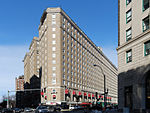New England School of Art and Design
1923 establishments in MassachusettsAC with 0 elementsEducational institutions established in 1923Suffolk UniversityUniversities and colleges in Boston
The New England School of Art and Design at Suffolk University is a school of fine arts and design located in Boston, Massachusetts. The school offers undergraduate (BFA) and graduate (MA) degrees, as well as continuing education courses and programs. The School of Art & Design is accredited by the National Association of Schools of Art and Design (NASAD). The BFA program in Interior Design and MA program in Interior Architecture & Design are accredited by the Council for Interior Design Accreditation (CIDA). Suffolk University is accredited by the New England Association of Schools and Colleges.
Excerpt from the Wikipedia article New England School of Art and Design (License: CC BY-SA 3.0, Authors).New England School of Art and Design
Arlington Street, Boston Back Bay
Geographical coordinates (GPS) Address Nearby Places Show on map
Geographical coordinates (GPS)
| Latitude | Longitude |
|---|---|
| N 42.3506 ° | E -71.0704 ° |
Address
Paine Furniture Building
Arlington Street 75
02117 Boston, Back Bay
Massachusetts, United States
Open on Google Maps









